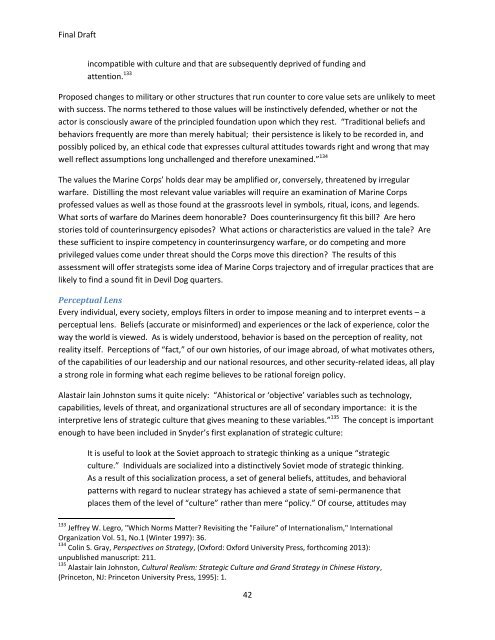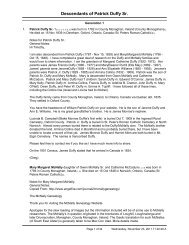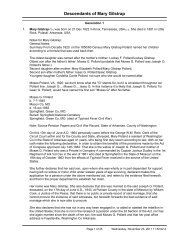Assessing the Strategic Impact of Service Culture on ...
Assessing the Strategic Impact of Service Culture on ...
Assessing the Strategic Impact of Service Culture on ...
You also want an ePaper? Increase the reach of your titles
YUMPU automatically turns print PDFs into web optimized ePapers that Google loves.
Final Draft<br />
incompatible with culture and that are subsequently deprived <str<strong>on</strong>g>of</str<strong>on</strong>g> funding and<br />
attenti<strong>on</strong>. 133<br />
Proposed changes to military or o<str<strong>on</strong>g>the</str<strong>on</strong>g>r structures that run counter to core value sets are unlikely to meet<br />
with success. The norms te<str<strong>on</strong>g>the</str<strong>on</strong>g>red to those values will be instinctively defended, whe<str<strong>on</strong>g>the</str<strong>on</strong>g>r or not <str<strong>on</strong>g>the</str<strong>on</strong>g><br />
actor is c<strong>on</strong>sciously aware <str<strong>on</strong>g>of</str<strong>on</strong>g> <str<strong>on</strong>g>the</str<strong>on</strong>g> principled foundati<strong>on</strong> up<strong>on</strong> which <str<strong>on</strong>g>the</str<strong>on</strong>g>y rest. “Traditi<strong>on</strong>al beliefs and<br />
behaviors frequently are more than merely habitual; <str<strong>on</strong>g>the</str<strong>on</strong>g>ir persistence is likely to be recorded in, and<br />
possibly policed by, an ethical code that expresses cultural attitudes towards right and wr<strong>on</strong>g that may<br />
well reflect assumpti<strong>on</strong>s l<strong>on</strong>g unchallenged and <str<strong>on</strong>g>the</str<strong>on</strong>g>refore unexamined.” 134<br />
The values <str<strong>on</strong>g>the</str<strong>on</strong>g> Marine Corps’ holds dear may be amplified or, c<strong>on</strong>versely, threatened by irregular<br />
warfare. Distilling <str<strong>on</strong>g>the</str<strong>on</strong>g> most relevant value variables will require an examinati<strong>on</strong> <str<strong>on</strong>g>of</str<strong>on</strong>g> Marine Corps<br />
pr<str<strong>on</strong>g>of</str<strong>on</strong>g>essed values as well as those found at <str<strong>on</strong>g>the</str<strong>on</strong>g> grassroots level in symbols, ritual, ic<strong>on</strong>s, and legends.<br />
What sorts <str<strong>on</strong>g>of</str<strong>on</strong>g> warfare do Marines deem h<strong>on</strong>orable? Does counterinsurgency fit this bill? Are hero<br />
stories told <str<strong>on</strong>g>of</str<strong>on</strong>g> counterinsurgency episodes? What acti<strong>on</strong>s or characteristics are valued in <str<strong>on</strong>g>the</str<strong>on</strong>g> tale? Are<br />
<str<strong>on</strong>g>the</str<strong>on</strong>g>se sufficient to inspire competency in counterinsurgency warfare, or do competing and more<br />
privileged values come under threat should <str<strong>on</strong>g>the</str<strong>on</strong>g> Corps move this directi<strong>on</strong>? The results <str<strong>on</strong>g>of</str<strong>on</strong>g> this<br />
assessment will <str<strong>on</strong>g>of</str<strong>on</strong>g>fer strategists some idea <str<strong>on</strong>g>of</str<strong>on</strong>g> Marine Corps trajectory and <str<strong>on</strong>g>of</str<strong>on</strong>g> irregular practices that are<br />
likely to find a sound fit in Devil Dog quarters.<br />
Perceptual Lens<br />
Every individual, every society, employs filters in order to impose meaning and to interpret events – a<br />
perceptual lens. Beliefs (accurate or misinformed) and experiences or <str<strong>on</strong>g>the</str<strong>on</strong>g> lack <str<strong>on</strong>g>of</str<strong>on</strong>g> experience, color <str<strong>on</strong>g>the</str<strong>on</strong>g><br />
way <str<strong>on</strong>g>the</str<strong>on</strong>g> world is viewed. As is widely understood, behavior is based <strong>on</strong> <str<strong>on</strong>g>the</str<strong>on</strong>g> percepti<strong>on</strong> <str<strong>on</strong>g>of</str<strong>on</strong>g> reality, not<br />
reality itself. Percepti<strong>on</strong>s <str<strong>on</strong>g>of</str<strong>on</strong>g> “fact,” <str<strong>on</strong>g>of</str<strong>on</strong>g> our own histories, <str<strong>on</strong>g>of</str<strong>on</strong>g> our image abroad, <str<strong>on</strong>g>of</str<strong>on</strong>g> what motivates o<str<strong>on</strong>g>the</str<strong>on</strong>g>rs,<br />
<str<strong>on</strong>g>of</str<strong>on</strong>g> <str<strong>on</strong>g>the</str<strong>on</strong>g> capabilities <str<strong>on</strong>g>of</str<strong>on</strong>g> our leadership and our nati<strong>on</strong>al resources, and o<str<strong>on</strong>g>the</str<strong>on</strong>g>r security-related ideas, all play<br />
a str<strong>on</strong>g role in forming what each regime believes to be rati<strong>on</strong>al foreign policy.<br />
Alastair lain Johnst<strong>on</strong> sums it quite nicely: “Ahistorical or ‘objective’ variables such as technology,<br />
capabilities, levels <str<strong>on</strong>g>of</str<strong>on</strong>g> threat, and organizati<strong>on</strong>al structures are all <str<strong>on</strong>g>of</str<strong>on</strong>g> sec<strong>on</strong>dary importance: it is <str<strong>on</strong>g>the</str<strong>on</strong>g><br />
interpretive lens <str<strong>on</strong>g>of</str<strong>on</strong>g> strategic culture that gives meaning to <str<strong>on</strong>g>the</str<strong>on</strong>g>se variables.” 135 The c<strong>on</strong>cept is important<br />
enough to have been included in Snyder’s first explanati<strong>on</strong> <str<strong>on</strong>g>of</str<strong>on</strong>g> strategic culture:<br />
It is useful to look at <str<strong>on</strong>g>the</str<strong>on</strong>g> Soviet approach to strategic thinking as a unique “strategic<br />
culture.” Individuals are socialized into a distinctively Soviet mode <str<strong>on</strong>g>of</str<strong>on</strong>g> strategic thinking.<br />
As a result <str<strong>on</strong>g>of</str<strong>on</strong>g> this socializati<strong>on</strong> process, a set <str<strong>on</strong>g>of</str<strong>on</strong>g> general beliefs, attitudes, and behavioral<br />
patterns with regard to nuclear strategy has achieved a state <str<strong>on</strong>g>of</str<strong>on</strong>g> semi-permanence that<br />
places <str<strong>on</strong>g>the</str<strong>on</strong>g>m <str<strong>on</strong>g>of</str<strong>on</strong>g> <str<strong>on</strong>g>the</str<strong>on</strong>g> level <str<strong>on</strong>g>of</str<strong>on</strong>g> “culture” ra<str<strong>on</strong>g>the</str<strong>on</strong>g>r than mere “policy.” Of course, attitudes may<br />
133<br />
Jeffrey W. Legro, "Which Norms Matter? Revisiting <str<strong>on</strong>g>the</str<strong>on</strong>g> "Failure" <str<strong>on</strong>g>of</str<strong>on</strong>g> Internati<strong>on</strong>alism," Internati<strong>on</strong>al<br />
Organizati<strong>on</strong> Vol. 51, No.1 (Winter 1997): 36.<br />
134<br />
Colin S. Gray, Perspectives <strong>on</strong> Strategy, (Oxford: Oxford University Press, forthcoming 2013):<br />
unpublished manuscript: 211.<br />
135<br />
Alastair lain Johnst<strong>on</strong>, Cultural Realism: <str<strong>on</strong>g>Strategic</str<strong>on</strong>g> <str<strong>on</strong>g>Culture</str<strong>on</strong>g> and Grand Strategy in Chinese History,<br />
(Princet<strong>on</strong>, NJ: Princet<strong>on</strong> University Press, 1995): 1.<br />
42

















